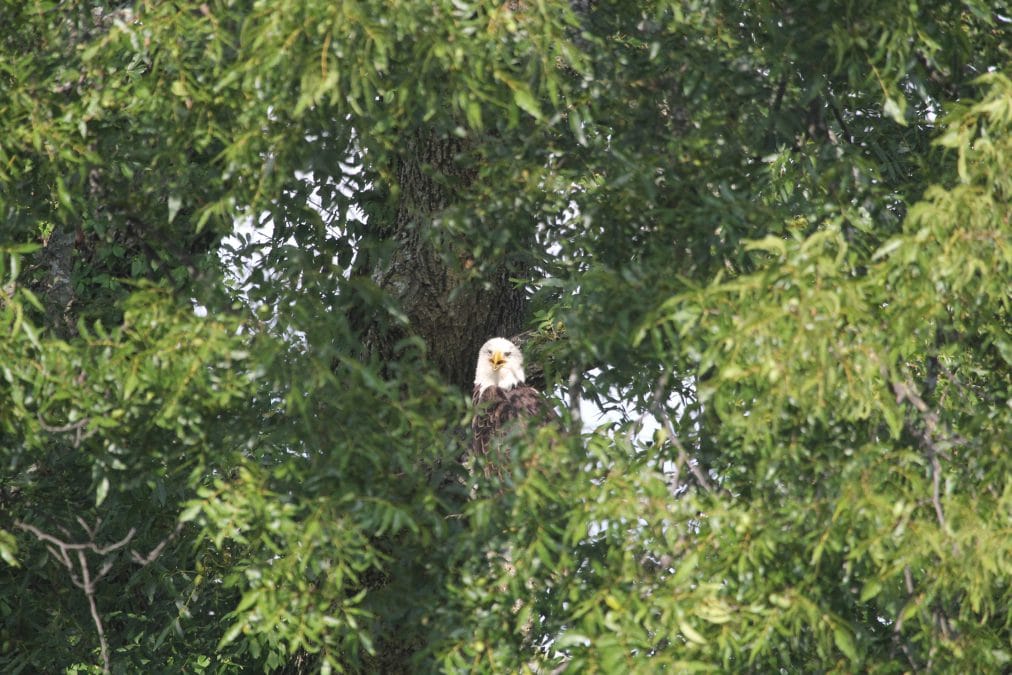By Bree Dunham and Jennifer Randell, CPN Eagle Aviary Managers
The first signs of fall for us here at the CPN Aviary weren’t the changing leaves or even the weather but instead the air around us that was filled with migrating birds and butterflies. Monarchs were in abundance, many females laying one last batch of eggs as they passed through to their wintering grounds in Mexico. Large kettles of turkey vultures slipped by, one after another, as they rode thermals south. We also began to see groups of Mississippi kites, nighthawks and flocks of gulls about the same time the hummingbird feeders, which had been overrun with frenzied feeding, sat nearly empty. Fall was here with migration well underway.

During the fall, we begin to gather items that will be needed to winterize enclosures and do any required maintenance or extensive site work now that the summer heat has passed. We also prepare for the breeding season and begin our yearly eagle and hawk nest site studies. We go over the previous year’s dates of nesting behaviors we noted, which include arrivals for nesting pairs, chicks in nests, fledgling and departures. While doing this, we couldn’t help but wonder about Wadasé Zhabwé. We have spent hours poring over her telemetry data since her GPS backpack stopped transmitting last November. Looking for patterns in frequent visits to areas during the fall and winter, we hope to narrow down locations that she might have chosen to nest. Although, there is one pattern and place unrelated to the focus of nesting that stands out. Wadasé has never failed to come home in the beginning of fall or during the winter months.
Every large bird that crosses the sky gets a second or third look, just in case. For weeks we’ve been on alert every time the eagle calls alert us to intruders above their airspace, with false alarms from turkeys walking too close to their enclosures and resident red-tails circling overhead. A few juvenile eagles have sent us scrambling to get binoculars, cameras or spotting scope, thinking it could be Mko Kno, but 2020 has been anything but predictable. And although the cause for alarm hadn’t been Wadasé or even Mko Kno yet, we continued to look.
With that in mind, it should come as no surprise that one evening in mid-September, we noticed something siting on the half-round enclosure. Neither of us could see clearly from where the aviary house now sets to determine exactly what it was. The eagles were quiet, and there were no alarm calls. But it definitely looked like a large bird of some kind looking down into the enclosure. As we stood watching, all of a sudden, the bird sat up and we could see a white head, and as its wings opened, we scrambled for binoculars. It took one half-flighted hop to the next rafter and looked back down. It was Wadasé. It had to be. No other bird in all this time has landed, done that to get a response, and not gotten a reaction from the eagles in the enclosure. We made our way to the aviary office to get a better look, and there was absolutely no mistake, seeing her sit on the edge of the enclosure as she peered in the office, Wadasé was home.
She was gorgeous and in perfect feather condition. However, when she flew from the corner of the aviary, we learned exactly why we had failed after numerous attempts to locate her GPS backpack anywhere near her last transmitted GPS point. We were shocked to learn that the unit was still seated squarely on her back. The problem was, the antennae was gone. She spent the evening out front in her favorite pecan tree until last light before heading west across the pasture. Sunrise, just like previous visits, there she was. She spent the better part of the day in and around the aviary, stopping by to rest in between flights to the river and adjacent west pasture. Our resident wild eagle pair, Martin and his mate, may have kept her from venturing too far east of the creek. Everyone is a little territorial with nesting around the corner. The following day, from sunrise to sunset, we didn’t see her.
Although her visit was short, it was a blessing to know that she is still thriving in the wild, and we have an answer about her telemetry. All of those “what ifs” and worries have been put to rest, and like all the other winged things that migrate, she has her patterns. We are fortunate that she chose to keep coming home, and with luck, we can use those patterns in the data to find her nesting grounds in hopes of following her and her offspring for years to come. For now, we are more than satisfied with this little victory in 2020 and look forward to the next visit. For more information about the CPN Eagle Aviary near Shawnee, Oklahoma, or to read previous updates, visit potawatomi.org or potawatomiheritage.com. Share your encounters with Wadasé, Mko Kno or any other eagles in Oklahoma or wherever you may be with us at aviary@potawatomi.org.
